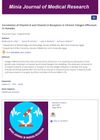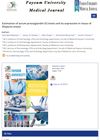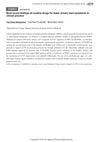Search
for
Sort by
Research
240-270 / 1000+ results
research Red Nail Bands in Conjunction with Telogen Effluvium as a Post-COVID-19 Phenomenon
Red stripes on nails and hair loss may occur after COVID-19.

research In Vitro Co-Culture Models of Merkel Cell-Neurite Complex in Touch Domes
The study concluded that the developed models are effective for studying hair growth mechanisms and testing new treatments.

research Effective Treatment of Alopecia Universalis with Oral Tofacitinib: A Case Report
Oral tofacitinib successfully treated total body hair loss in one patient.

research Plica Polonica: Trichoscopic Findings with a Brief Literature Review
Plica polonica is a rare condition where hair becomes irreversibly tangled, and the treatment is to cut the matted hair.

research Trichoscopy as an Essential Diagnostic Technique for Hair and Scalp Disorders in Skin of Color: A Case-Control Study
Trichoscopy is a reliable method for diagnosing hair and scalp disorders quickly and non-invasively.
research Follicular Unit: The Center for Hair Transplants
New hair transplant methods now look more natural.
research Anti-DFS70 as a Marker of Non-Systemic Autoimmune Events (Primary Biliary Cholangitis) in Systemic Lupus Erythematosus
Anti-DFS70 antibodies can help identify nonsystemic autoimmune conditions in SLE patients.

research Hair Follicle Stem Cell Progeny Heal Blisters While Pausing Skin Development
Skin healing from blisters can delay hair growth as stem cells focus on repairing skin over developing hair.

research Correlation of Vitamin D and Vitamin D Receptors in Chronic Telogen Effluvium in Females
Low Vitamin D and its receptors might be linked to chronic hair loss in women.

research The Association Between Serum Zinc Levels and Subjective Symptoms in Zinc Deficiency Patients with Chronic Liver Disease
Low zinc levels in chronic liver disease patients are linked to more severe symptoms like taste issues and skin problems, and zinc supplements might help.

research Estimation of Serum Prostaglandin D2 Levels and Its Expression in Tissue of Alopecia Areata
People with Alopecia areata have higher levels of prostaglandin D2 in their blood and tissues.

research Alteration in Asbabe-Sitta-Zaruriyah (Six Essential Prerequisites for Maintaining Health) to Prevent Intithar al-Sha‘r (Telogen Effluvium): An Insight
Changing six essential health practices can help prevent excessive hair shedding.
research Application of PLGA Nanostructures to Cosmetics
PLGA nanospheres in cosmetics improve skin and hair treatment effectiveness.

research The Efficacy of Ostrich Antibodies to Dihydrotestosterone and 5α-Reductase in the Restoration of Hair Growth
Ostrich antibodies can help restore hair growth in people with a specific type of hair loss, increasing hair count by 71% on average.

research Most Recent Findings of Curative Drugs for Lower Urinary Tract Symptoms in Clinical Practice
Current treatments for lower urinary tract symptoms include α1-blockers, 5ARIs, PDE5 inhibitors, anticholinergic agents, and β3-adrenergic receptor agonists.

research Hair Follicle Epidermal Stem Cells Define a Niche for Tactile Sensation
Skin stem cells in hair follicles are important for touch sensation.

research Diagnosis of Pemphigus Foliaceus in a Pinscher: Case Report
An 11-year-old female Pinscher with Pemphigus Foliaceus was successfully diagnosed and treated.

research The Relationships Between Ruminal Juice, Urine, Serum, and Fecal Zinc in Experimentally Zinc Deficient Ossimi Lambs
Zinc levels in body fluids can help diagnose zinc deficiency in lambs, with fecal zinc as an early indicator.

research Restoration Mechanism of Hair Using Hematin as Treatment Agent
Hematin in shampoo helps repair and straighten damaged hair.
research Isoproterenol Directs Human Hair Follicle-Associated Pluripotent Stem Cells to Differentiate to Cardiac Muscle Cells
Human hair follicles can be used to create heart muscle cells.
research Hair Follicle Associated Pluripotent (HAP) Stem Cells from Young Mice Have the Greatest Potential to Differentiate to Cardiac Muscle Cells
Young mice's hair follicle stem cells are best for turning into heart muscle cells.

research Dual Aspects of B Cells in Tumor Immunity: Positive and Negative Regulation Against B16 Melanoma
B cells can both help and hinder the body's defense against melanoma.
research Human Hair-Follicle Associated Pluripotent (HAP) Stem Cells Differentiate to Cardiac Muscle Cells
Human hair follicles can produce stem cells that turn into heart muscle cells.
research Autophagy Stimulation Improves Erythroid Proliferative Capacity in Models of SF3B1 Mutant MDS
Tofacitinib helped most teenagers in the study regrow hair with mild side effects.

research Lower Prostate Cancer Risk in Swedish Men with the Androgen Receptor E213 A-Allele
Swedish men with the E213 A-allele of the androgen receptor have a lower risk of prostate cancer.

research Whisker Follicles Transplanted to the Spine of Nude Mice for Spinal Cord Repair Generate Extensive Ectopic Hair Growth
Transplanted whisker follicles caused hair growth on the spine of mice.
research Hair-Follicle-Associated Pluripotent Stem Cells
HAP stem cells can repair nerves and spinal cords by becoming Schwann cells.

research Analysis on the Maintenance Mechanisms of Human Interfollicular Epidermal Stem Cells and Their Niche
Epidermal stem cells use integrin β1 and α6 as markers and CD271+ cells help maintain skin health and heal wounds.
research Use of Human Induced Pluripotent Stem Cell-Derived CD271+CD90+ Mesenchymal Stem Cells for the Generation of Hair Inductive Dermal Cells
Human induced pluripotent stem cells can be used to create cells that help grow hair.